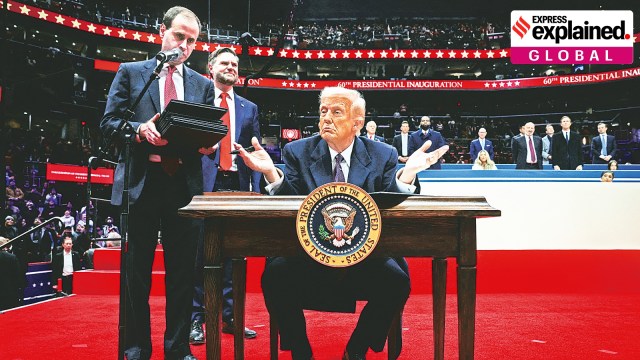Why Donald Trump’s Paris Agreement pullout could have worse consequences than in 2017
During his inauguration speech, Trump promised to reverse some of the climate-friendly energy policies of the last few years, and reiterated his commitment to extracting more oil and gas to meet America’s energy requirements.
 US President Donald Trump at the signing of executive orders after being sworn into office on Inauguration Day of his second term on January 20. Reuters
US President Donald Trump at the signing of executive orders after being sworn into office on Inauguration Day of his second term on January 20. ReutersUS President Donald Trump decided to withdraw the United States from the Paris Agreement again — having first done so in 2017 — through an executive order signed on Monday. On his first day in office, Trump also ordered an immediate revocation of all climate finance commitments made by the US.
During his inauguration speech, Trump promised to reverse some of the climate-friendly energy policies of the last few years, and reiterated his commitment to extracting more oil and gas to meet America’s energy requirements.
Trump’s predecessor (and successor) Joe Biden had taken the US back into the Paris Agreement in 2021. The US is the only one of the 194 member countries to have withdrawn from it. Incidentally, the US had not become a party to the 1997 Kyoto Protocol as well, having refused to ratify it after signing on to it. The predecessor to the Paris Agreement expired in 2020.
Greater impact this time
The US is the world’s second-largest emitter of greenhouse gases. The Paris Agreement’s objective of keeping global warming below a certain level cannot be achieved without its full participation in the common effort to reduce emissions.
In many ways, this second withdrawal could have a more far-reaching impact on global climate action than the first. The decision has come at the start of Trump’s second term and is accompanied by a slew of related decisions that threaten to dismantle the entire US climate policy.
The first withdrawal, which came six months into the Trump presidency, was rather short-lived. The US had ratified the Paris Agreement just a few months before Trump had become President. It has a provision that does not allow any country to withdraw within the first three years of ratification. There is also a one-year wait time for the withdrawal to come into effect. So, by the time the US withdrawal became effective, it was almost time to rejoin, with Biden winning the election.
The process will be much swifter this time, and the withdrawal will come into effect next year. Trump also appears more clear about his policies, having already ordered the rollback of several energy-related policies. He has also sought an immediate review of all regulations that hinder the development of domestic energy resources, including oil, natural gas and coal.
Conventional energy pitch
The production of crude oil and natural gas in the US increased during Trump’s first term, though coal extraction reduced substantially. But this was largely in keeping with the overall trend in the US. Both its crude oil and natural gas production have shown an increasing trend in the last 15 years, except for a marginal dip during the coronavirus pandemic. This did not change during the Biden presidency either. (Charts)
Trump has been much more explicit about drilling new oil wells and gas fields this time, as a result of which fossil fuel production could see a sharp spike in the next four years. Some earlier estimates of the impact of Trump’s expected policies suggested that an additional 4 billion tonnes of emissions could be added over the next four years.
Another major implication for developing countries will be a further squeeze in funds available for climate action. Trump has ordered an immediate revocation of the US International Climate Finance Plan, an April 2021 announcement that promised to scale up US contribution to $11 billion annually by 2024. Last year, the US claimed its preliminary estimates as suggesting that this pledge was met.
But it is not just the US government’s contribution that would be affected. The US has the greatest influence on mobilising private and international finance, which forms the bulk of the money that gets channelled into climate action. Trump’s policies could see this source drying up as well.
According to Trump, these measures are meant to protect American interests. In particular, the heavy concentration of the renewable energy supply chain in China makes the US extremely vulnerable to energy shocks. He has, therefore, talked about boosting the domestic production of renewable energy equipment through tariffs on cheaper Chinese equipment. Scaling up of domestic production of solar or wind energy would also result in the creation of new jobs — another important agenda for Trump.
Meanwhile, increasing the production of oil and gas, which the US has in abundance, can help in energy security and self-reliance, reducing the dependence on China while boosting employment.
Upshot
The biggest irritant in this scheme of things would be the Paris Agreement requirement that the US cut down on its emissions. Trump has thus decided to do away with the agreement itself. He has long complained that international regulations on climate change have been unfair to the US because similar restrictions are not placed on China, on account of it being classified as a developing country.
However, the fact is the US has the largest share of historical emissions, and therefore also the greatest responsibility to clean up — and it has not done even a fraction of what it is mandated to.
The fallout of Trump’s second term on the international climate regime will be known in due course. What appears certain is that the US would be unable to meet its 2030 emissions cut targets. It is currently attempting to reduce its emissions by 50-52% by 2030 (from 2005 levels) and by 62-66% by 2035. As of now, the US is not on track to meet its 2030 emissions goal — and four years of Trump will make it almost certain that these are not achieved.
- 01
- 02
- 03
- 04
- 05






































